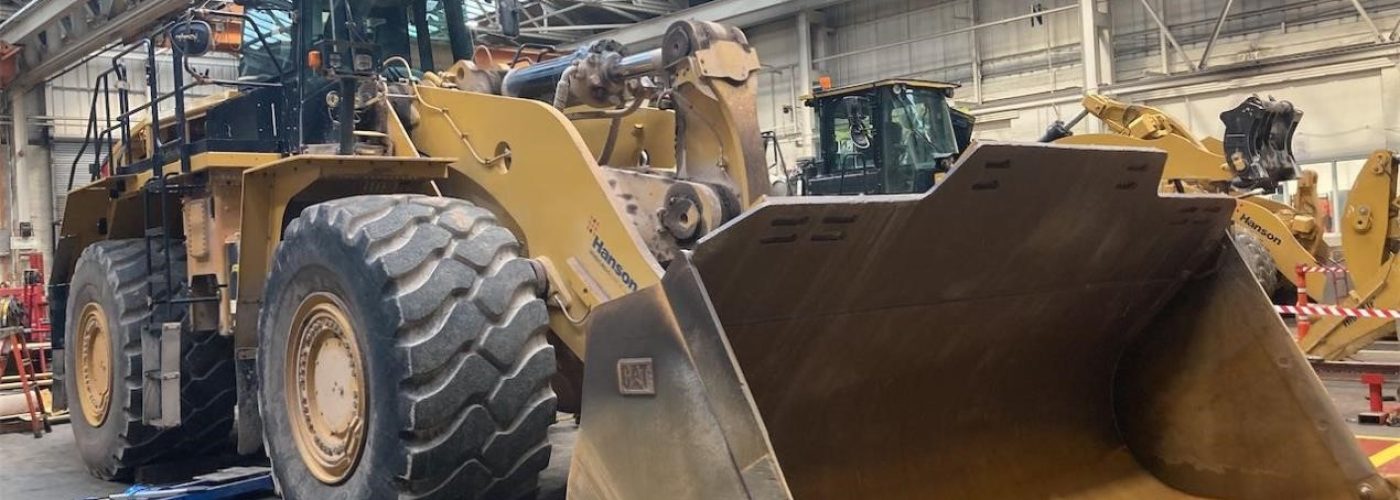Commissioning machine rebuilds is already an integral part of Heidelberg Materials UK’s fleet management plan. This month the company welcomed a rebuilt Cat® 988K XE with electric drive back to its Whatley asphalt plant following a Cat Certified Powertrain Rebuild, giving it a new lease of life and many more hours of operating capability.
The electric drive machine has been operating at the plant in Somerset since 2018 when the company bought it from Finning, the world’s largest dealer of Cat equipment and parts. It was purchased with one of the top-level warranty packages offered by Finning, which included a full servicing and maintenance programme and remote asset condition monitoring so any faults could be identified and fixed before the machine is at risk of failure.
As the machine began to reach 18,000 hours, the operational team began discussions with Finning to identify the best solution for replacement that fulfilled both the company’s commercial needs and sustainability objectives. Having had a full service and maintenance programme meant the machine was in good condition to be rebuilt.
“Finning guided us through the process of comparing the benefits of buying a new machine with having the machine rebuild instead,” explained Luke Morgan, Fleet Manager for Heidelberg Materials UK.
“We carefully considered all the benefits and concluded that the rebuild was the best option for us at this time. Doing so not only supports our company-wide commitment to sustainability and enables us to reduce our carbon footprint, but crucially, choosing to have the machine rebuilt also meant we could have it back operating on-site within 12-weeks. Finning was also able to provide a five-year warranty giving us reassurance that the machine will continue to operate effectively during its next life.”
The Cat 988K XE was first launched in the UK in 2017 and is the first wheel loader from Caterpillar® fitted with an electric drive. It makes use of switched reluctance technology –an electric motor that runs by reluctance torque, and is equipped with a powerful Caterpillar engine, providing up to 579 horsepower enabling the operator to drive the machine at up to 40km per hour. It also provides optimised performance and serviceability, allowing operators to move material on site efficiently and safely at a lower cost per tonne. The 988K XE also emits up to 37% less CO2 an hour than its predecessor – the Cat 988K – and 45% less CO2 per tonne of material used.
In 2022, Cat launched an upgraded version of the Cat 988K XE. The newer version can deliver up to 10% faster downhill speeds, improved rim pull, and increased hydraulic breakout force resulting in a further increase in productivity on the previous model of around 5%. The latest version also improves cycle times in load and carry applications and offers faster manoeuvrability as a result of having an optional counterweight which increases stability.
Mark Tudball, Engine & Drivetrain Product Manager at Finning explains the additional benefits of choosing a rebuild for this machine: “The electric drive transmission in the Cat 988K XE means there are fewer moving parts than on a manual transmission. This means there are less components – around 20% fewer – and therefore less moving parts to recondition and replace as part of the rebuild process.
“Although there are more electrical inspections needed once the rebuild is done, a large proportion of the electrical components, such as the power inverter and drive motors, can be removed from the original machine and reused making it a more circular, sustainable option for customers. Caterpillar reuse and salvage guidelines ensure we can offer a second life to components if they pass this process.
“A further advantage is that the rebuilt machine benefits from having the latest engineering updates, which may include parts or electronic software. So despite being built originally in 2017, the rebuilt machine has the same functionality and performance of the later 2022 model, ensuring maximum longevity and efficiency.”
“Rebuilding the latest technologically advanced machines shows a rebuild is not purely for older machines, the rebuild offering is aligned with newer technologies and is moving with the times to ensure the latest new machines sold have a rebuild solution in place when needed”.
Gary Huxley, Product Support Sales Manager at Finning, said: “Managing machines throughout their operational life is a key part of Heidelberg Materials UK’s fleet management approach. We’ve worked with the company for more than 20 years with Cat machines making up a large proportion of its total fleet.
“They typically take advantage of the engineering support and warranty packages we offer to ensure their machines are maintained and serviced and kept operating effectively, while minimising unexpected downtime.
“Rebuilt machines are becoming a mainstay in the company’s fleet. Between 2021 and 2023 they have had 14 machines rebuilt, including a Cat 988K that had a Cat Certified Powertrain rebuild at 17,000 hours and is still going strong at 28,600, and a Cat 988H which has been rebuilt several times and is still operating with 47,000 hours on the clock. The company has also previously commissioned rebuilds of a Cat 972, five Cat 980s and seven Cat 775s.
“The success of previous rebuilds was certainly a factor in their decision to choose to have this latest machine rebuilt and they have already commissioned the rebuild of their second Cat 988K XE machine operating at the asphalt plant in Whatley.”
Luke Morgan, Fleet Manager for Heidelberg Materials UK, said: “Sustainability is at the heart of our operations. We have set ourselves ambitious targets and we are already making significant gains, having reduced our operational CO2 emissions by more than 50% since 1990.” “ We’re always looking for new processes and technologies that will enable our transport and heavy equipment fleet to be more efficient. A big part of this is increasing the use of products that have a lower carbon footprint.”
Building, Design & Construction Magazine | The Choice of Industry Professionals





